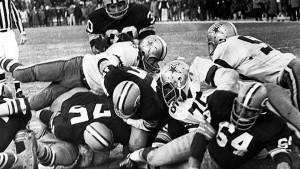
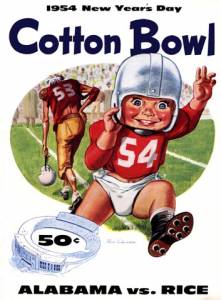
Now that Bart Starr has entered eternal rest, I had to look into his life and career. Sixteen years as the Green Bay Packers’ quarterback and five championships (including the first two Super Bowls, in both of which he was named MVP) say enough. You may remember that he scored on a QB sneak against the Dallas Cowboys to win the “Ice Bowl” on December 31, 1967. I liked him as a player and respected him as a man; Starr oozed integrity. A native of Montgomery, he played at the University of Alabama from 1952 through 1955. (Although it is not germane to our story, I will state why he scarcely got on the field as a junior and senior after having done so well as a soph. Starr underwent a brutal hazing initiation to join the varsity lettermen’s A-Club before spring training of 1954. His injured back was such that the doctors put him in traction at a Tuscaloosa hospital. It bothered him throughout his pro career and for the rest of his life. An agreed-upon fib [he stuck to the story in his 1987 autobiography] held that Starr had merely strained his back while punting a football. His wife revealed the dark secret in 2016. By that time, the old guy had suffered two strokes and could no longer communicate. Surviving teammates confirmed Mrs. Starr’s account.)
The Crimson Tide had won the 1953 Southeastern Conference title and earned a spot in the Cotton Bowl on January 1 against Rice. Jess Neely’s Owls, Southwest Conference co-champs, would go on to win that game in Dallas by a score of 28-6. Bama took an early lead when Tommy Lewis—remember that name—scored on a 2-yard plunge. Early in the second quarter, though, Rice’s Dickey Maegle evaded Starr (some players went two ways back then) and scored on a 79-yard run. Not long thereafter, the Owls were on their 5-yard line. Maegle took a handoff from quarterback LeRoy Fenstemaker, swept around right end and again got by Starr. He really took off. I am not going to say Maegle was an early version of Eric Dickerson, but he was quite swift. He, Texas A&M’s John Kimbrough, SMU’s Doak Walker, TCU’s Jim Swink, Arkansas’s Lance Alworth, UT’s James Saxton and Texas Tech’s Donny Anderson were among a small number of SWC players in the pre-integration era who would have succeeded today.
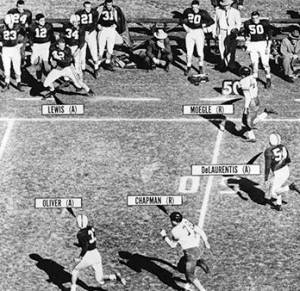
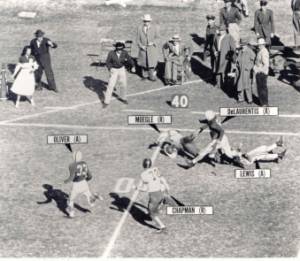
At any rate, the Owls’ fine halfback—he was a consensus all-American and came in sixth in Heisman Trophy voting the next season—was off to the races. He roared down the right sideline and would not have been caught, as Lewis must have realized. Helmetless, he impulsively left the bench and knocked Maegle to the turf at the Tide’s 42-yard line, retreated and looked for a place to hide. I have studied the film and photos of this, one of college football’s most famous scenes, and find some fascinating points. For one, the Alabama players were way back from the sideline. Nowadays, guys on every team are up as close as possible. Also, Lewis put quite a lick on Maegle although he saw him to the right in his peripheral vision. Maegle went down and, although in considerable pain, was not injured. Third, I am amazed how calm the Owls were about what they had witnessed. None came at Lewis and threatened to kick his ass. In fact, all I saw was a male Rice cheerleader pointing to number 42 on the Alabama bench. Lewis was already sobbing and asking, “Oh, God, what have I done?” Referee Cliff Shaw gave Maegle a 95-yard touchdown under the rarely enforced “palpably unfair act” rule. It’s possible that Lewis thought Bama would have been given just a 5-yard penalty for illegal participation, although I find that unlikely. Lewis’ boneheaded move was hasty and impetuous, nothing more.
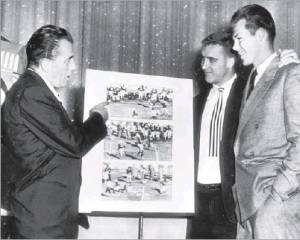
Maegle also got loose for a 34-yard TD run in the third quarter, finishing with 265 yards on 11 carries, a 24-yard average. While Moegle was, as indicated above, a superb running back, the Crimson Tide defense that day at the Cotton Bowl must have been lousy. The game over, a mortified Lewis found Moegle, shook his hand and apologized. Two days later, they appeared on The Ed Sullivan Show, going over all that had happened. Their names have been linked ever since.
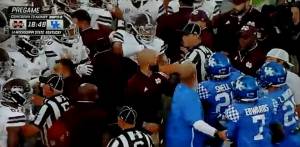
The mature and sportsmanlike manner of Maegle and his Rice teammates stands in stark contrast to what is on frequent display in today’s game. In the 2018 season alone, there were plenty of dreadful examples. How about the brawl between LSU and Miami? Or Mississippi State and Kentucky? Or Duke and Georgia Tech? Or North Carolina State and North Carolina? Or Florida State and Miami? Or Baylor and Iowa State? Or Florida and Vanderbilt? Or Central Michigan and Toledo? Or Texas A&M and LSU? Such incidents are often sparked not just in the heat of competition but before kickoff as hyper-macho players woof and seek to intimidate their opponents. These heavily tatted hooligans in shoulder pads are, in my view, indicative of a society in regression.
As for the two dramatis personae, Lewis played a little ball in the CFL, got into the insurance business and died in 2014—still lamenting his foolish act at the Cotton Bowl 60 years earlier. Maegle had six seasons with the San Francisco 49ers, Pittsburgh Steelers and Dallas Cowboys, mostly as a defensive back. He did some announcing for the Houston Oilers, ran a night club and operated several hotels before retiring.

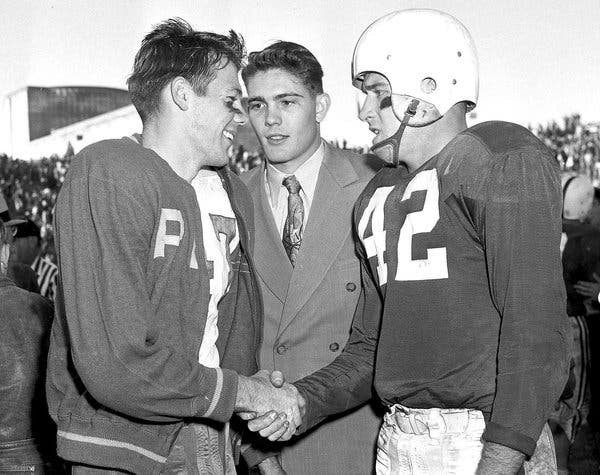
4 Comments
Richard:
Outstanding article! I remember seeing the game on TV when I was 10 years old.
I also followed the career of Moegle who was an outstanding defensive back. And I think Lindsay Nelson was the Cotton Bowl TV announcer.
Thanks for sharing,
Rex
Thanks, Rex. I was in Dallas when the game took place, but I was just 13 months old!
You game me a lot of info on a play I remembered but didn’t know anything about. Just a split second decision that changed his life forever!
Kenny, you are right. I read an article about Lewis in which he discussed how much he regretted what he did that day.
Add Comment